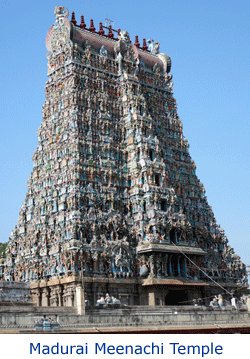MEENAKSHI TEMPLE................................................................................................................................................................................................................................................................................... Once Dhananjaya, a merchant of Manavur, where the Pandyas had arrived after the second deluge in Kumari Kandam, having been overtaken by nightfall in Kadamba forest, spent the night in the Indra Vimana. When next morning he woke up, he was surprised to see signs of worship. Thinking that it must be the work of the Devas, he told the Pandya, Kulasekhara, in Manavur, of this. Meanwhile Lord Shiva had instructed Pandya in a dream to build a temple and a city at the spot Dhananjaya would indicate. Kulasekhara did so. Thus originated the temple and city. When the next Pandya, Malayadhvaja, and his queen, Kanchanamala, performed a sacrifice for a child, Lord Shiva caused Goddess Parvati Herself to step out of the fire as a little girl. She had three breasts. Lord Shiva told the couple that the third breast would disappear when she set eyes on he who was to be her husband. They were to name her "Thadathagai" and bring her up as if she were a boy. She succeeded her father to the throne at his death. She gained many military victories. Finally she marched on Kailasa itself. When she saw Lord Shiva, her third breast disappeared. The Lord told her to return to Madurai and said that He would marry her there. The divine marriage was celebrated. This is the theme much beloved of Madurai artists. There is a superb sculpture of this in the temple. The crowning of Meenakshi, for She was the same as Thadathagai, is celebrated as a festival in the temple. The Lord performed many miracles at the wedding. These are described in a celebrated poem, the "Tiruviayadal Puranam". Under the name of "Sundara Pandya", the Lord ruled the land as a mortal. After sometime, crowning Lord Muruga, their son, who was named "Ugra Pandya", Sundara Pandya and Thadathagai went into the temple and assumed divine forms as "Lord Somasundara" and "Goddess Meenakshi" respectively. Paranjothi Munivar wrote the Tiruviayadal Puranam in the sixteenth century. It is regarded as the temple's Sthalapurana. An earlier work adds a few celestial sports not included in the latter. These are, or rather were painted on the walls around the Golden Lily Tank. Some of the painted wooden panels are in the Temple Museum. The earliest references available to any structure in this temple is a hymn of Sambhandar's, in the seventh century, which refers to the "Kapali Madil". The present inner walls of the Lords shrine bear this name today. In the early times the entire temple must have been confined to the area between these walls, and the structures must have been of brick and mortar. In the 14th century an invasion by Malik Kafur damaged the temple. In the same century Madurai was under Muslim rule for nearly fifty years. The temple authorities closed the sanctum, covered up the Linga, and set up another in the Ardhamandapa. When the city was liberated, the sanctum was opened, and, tradition says the flower garlands and the sandalwood paste placed on the Linga were as fresh as on the first day, and two oil lamps were still burning. |
|||||||
|
|
|||||||



 The Sri Meenakshi Sundareswara temple and Madurai city
originated together. According to tradition, Indra once
committed sin when he killed a demon, who was then
performing penance. He could find no relief from remorse in
his own kingdom. He came down to earth. While passing
through a forest of Kadamba trees in Pandya land, he felt
relieved of his burden. His servitors told him that there
was a Shivalinga under a Kadamba tree and beside a lake.
Certain that it was the Linga that had helped him; he
worshipped it and built a small temple around it. It is
believed that it is this Linga, which is till under worship
in the Madurai temple. The shrine is called the "Indra
Vimana".
The Sri Meenakshi Sundareswara temple and Madurai city
originated together. According to tradition, Indra once
committed sin when he killed a demon, who was then
performing penance. He could find no relief from remorse in
his own kingdom. He came down to earth. While passing
through a forest of Kadamba trees in Pandya land, he felt
relieved of his burden. His servitors told him that there
was a Shivalinga under a Kadamba tree and beside a lake.
Certain that it was the Linga that had helped him; he
worshipped it and built a small temple around it. It is
believed that it is this Linga, which is till under worship
in the Madurai temple. The shrine is called the "Indra
Vimana".
